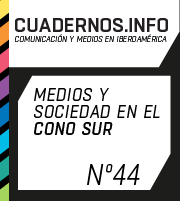Análisis de vídeos sobre cáncer de mama en YouTube
DOI:
https://doi.org/10.7764/cdi.44.1528Palabras clave:
Youtube, vídeos, cáncer de mama, repercusión, fiabilidadResumen
El artículo estudia las características y fiabilidad de 76 vídeos de YouTube sobre cáncer de mama, relacionándolas con su repercusión y valor para los usuarios. El análisis se basa en una plantilla que incluye elementos cuantitativos y cualitativos. Los resultados muestran una gran diversidad de formatos y promotores, frente a una mayor uniformidad en cuanto al tipo de contenido y el tono. Aunque predominan los vídeos informativos de tono neutral, los datos reflejan la preferencia de los usuarios por vídeos más subjetivos y menos fiables.
Descargas
Citas
Adhikari, J., Sharma, P., Arjyal, L., & Uprety, D. (2016). YouTube as a source of information on cervical cancer. North American journal of medical sciences, 8(4), 183-186. https://doi.org/10.4103/1947-2714.179940
Andréu, J. (2002). Las técnicas de análisis de contenido: una revisión actualizada. Documentos de trabajo. Serie Sociología (Content analysis techniques: an updated review. Work documents. Sociology Series). Sevilla: Fundación Centro de Estudios Andaluces.
Basch, C. H., Basch, C. E., Hillyer, G. C., & Reeves, R. (2015). YouTube videos related to skin cancer: a missed opportunity for cancer prevention and control. JMIR cancer, 1(1). https://doi.org/10.2196/cancer.4204
Basch, C. H., Hillyer, G. C., MacDonald, Z. L., Reeves, R., & Basch, C. E. (2015). Characteristics of YouTube™ videos related to mammography. Journal of Cancer Education, 30(4), 699-703. https://doi.org/10.1007/s13187-014-0769-9
Basch, C. H., Menafro, A., Mongiovi, J., Hillyer, G. C., & Basch, C. E. (2017). A Content Analysis of YouTube™ Videos Related to Prostate Cancer. American Journal of Men’s Health, 11(1), 154-157. https://doi.org/10.1177/1557988316671459
Bray, F., Ferlay, J., Soerjomataram, I., Siegel, R. L., Torre, L. A., & Jemal, A. (2018). Global cancer statistics 2018: GLOBOCAN estimates of incidence and mortality worldwide for 36 cancers in 185 countries. CA: a cancer journal for clinicians, 68(6), 394-424. https://doi.org/10.3322/caac.21492
Cooper, C. P., Gelb, C. A., & Chu, J. (2016). Gynecologic Cancer Information on YouTube: Will Women Watch Advertisements to Learn More?. Journal of Cancer Education, 31(3), 602-604. https://doi.org/10.1007/s13187-015-0830-3
Corbacho, J. M., Dafonte, A., & Míguez, M. I. (2018). ¿Son útiles los posts de Facebook favoritos de los usuarios para generar públicos informados y activos? Estudio de caso de las organizaciones contra el cáncer de mama (Are users’ favorite Facebook posts useful to generate informed and active audiences? Case study of breast cancer organizations). Revista Internacional de Relaciones Públicas, 7(15), 177-196. https://doi.org/10.5783/RIRP-15-2018-10-177-196
Fernández-Gómez, E. & Díaz-Campo, J. (2016). Comunicación sobre el cáncer en Facebook: Las asociaciones de Argentina, Chile, Colombia y España (Communication about cancer on Facebook. Organizations of Argentina, Chile, Colombia and Spain). Cuadernos.info, (38), 35-50. https://doi.org/10.7764/cdi.38.926
Grunig, J. E. & Hunt, T. T. (1984). Managing Public Relations. New York: Holt, Rinehart and Winston.
Hallyburton, A. & Evarts, L. A. (2014). Gender and online health information seeking: A five survey meta-analysis. Journal of Consumer Health on the Internet, 18(2), 128-142. https://doi.org/10.1080/15398285.2014.902268
Hassona, Y., Taimeh, D., Marahleh, A., & Scully, C. (2016). YouTube as a source of information on mouth (oral) cancer. Oral diseases, 22(3), 202-208. https://doi.org/10.1111/odi.12434
Jensen, J., Moriarty, C., Hurley, R., & Stryker, J. (2010). Making sense of cancer news coverage trends: A comparison of three comprehensive content analyses. Journal of Health Communication, 15(2), 136–151. https://doi.org/10.1080/10810730903528025
Lee, S. Y. & Hawkins, R. (2010). Why do patients seek an alternative channel? The effects of unmet needs on patients’ health-related Internet use. Journal of health communication, 15(2), 152-166. https://doi.org/10.1080/10810730903528033
Li, N., Orrange, S., Kravitz, R. L., & Bell, R. A. (2014). Reasons for and predictors of patients’ online health information seeking following a medical appointment. Family practice, 31(5), 550-556. https://doi.org/10.1093/fampra/cmu034
Li, J., Theng, Y. L., & Foo, S. (2016). Predictors of online health information seeking behavior: Changes between 2002 and 2012. Health informatics journal, 22(4), 804-814. https://doi.org/10.1177/1460458215595851
Madathil, K. C., Rivera-Rodriguez, A. J., Greenstein, J. S., & Gramopadhye, A. K. (2015). Healthcare information on YouTube: a systematic review. Health informatics journal, 21(3), 173-194. https://doi.org/10.1177/1460458213512220
Myrick, J. G. & Oliver, M. B. (2014). Laughing and crying: Mixed emotions, compassion, and the effectiveness of a YouTube PSA about skin cancer. Health communication, 30(8), 820-829. https://doi.org/10.1080/10410236.2013.845729
Nichols, B. (1997). La representación de la realidad. Cuestiones y conceptos sobre el documental (Representing Reality: Issues and Concepts in Documentary). Madrid: Paidós Ibérica.
Ruppert, L., Køster, B., Siegert, A. M., Cop, C., Boyers, L., Karimkhani, C., ... & Diepgen, T. (2017). YouTube as a source of health information: Analysis of sun protection and skin cancer prevention related issues. Dermatology Online Journal, 23(1). Retrieved from https://escholarship.org/uc/item/91401264
Tan, M. L. H., Kok, K., Ganesh, V., & Thomas, S. S. (2014). Patient information on breast reconstruction in the era of the world wide web. A snapshot analysis of information available on YouTube.com. The Breast, 23(1), 33-37. https://doi.org/10.1016/j.breast.2013.10.003
Tuells, J., Martínez-Martínez, P. J., Duro-Torrijos, J. L., Caballero, P., Fraga-Freijeiro, P., & Navarro-López, V. (2015). Características de los vídeos en español publicados en YouTube sobre la vacuna contra el virus del papiloma humano (Characteristics of the Videos in Spanish Posted on YouTube about Human Papillomavirus Vaccines). Revista española de salud pública, 89(1), 107-115. Retrieved from https://www.mscbs.gob.es/biblioPublic/publicaciones/recursos_propios/resp/revista_cdrom/vol89/vol89_1/RS891C_JTH.pdf
Vidyard. (2017). 2017 Video in Business. Benchmark Report (PDF file). Retrieved from https://blog.americansforthearts.org/sites/default/files/Video-in-Business-Benchmark-Report-2017.pdf
We are social & Hootsuite. (2018). Global Digital Report 2018. Retrieved from https://digitalreport.wearesocial.com/
Welbourne, D. J. & Grant, W. J. (2016). Science communication on YouTube: Factors that affect channel and video popularity. Public Understanding of Science, 25(6), 706-718. https://doi.org/10.1177/0963662515572068















